 W
WBodyweight exercises are strength-training exercises that use an individual's own weight to provide resistance against gravity. Bodyweight exercises can enhance a range of biomotor abilities including strength, power, endurance, speed, flexibility, coordination and balance. Such strength training has become more popular among recreational and professional athletes. Bodyweight training uses simple abilities like pushing, pulling, squatting, bending, twisting and balancing. Movements such as the push-up, the pull-up, and the sit-up are among the most common bodyweight exercises.
 W
WA back lever is a static hold performed on the rings or the pull-up bar. A back lever is rated as an 'A' value skill on the Code of Points, a scale from A to F, with F being the most difficult.
 W
WBarre is a form of physical exercise, usually conducted in group classes in gyms or specialty studios. It is distinguished from other group fitness activities by its use of the ballet barre and its incorporation of movements derived from ballet. These classical dance movements and positions are combined with those drawn from yoga and pilates, and other equipment is sometimes used in addition to the barre, such as resistance bands, yoga straps, exercise balls and hand weights. Barre classes typically focus on small, pulsing movements with emphasis on form, alignment and core engagement. Participants hold their bodies still while contracting specific, targeted sets of muscles in isometric exercises. Repetitions tend to be high, range-of-motion small, and weights, when used, light. Barre classes focus on the lower body and core, developing strength and flexibility from the ankles up though the calves, knees, thighs, glutes and abdominals. Holding muscles in contraction for extended periods frequently leads to them shaking as they fatigue. This is particularly true of thighs, as the quadriceps tire.
 W
WThe bridge is an exercise. Many variations of this exercise are employed throughout the world, most commonly the balancing of the body on the hands and the feet. It is intended to improve lower back and gluteus strength. Examples of bridging in sportive or self-defense applications are seen in Kung Fu, Judo, Brazilian jiu jitsu, Capoeira, mixed martial arts, and wrestling.
 W
WThe burpee, a squat thrust with an additional stand between repetitions, is a full body exercise used in strength training. The movement itself is primarily an anaerobic exercise, but when done in succession over a longer period can be utilized in as an aerobic exercise.
 W
WCalisthenics or callisthenics (/ˌkælɪsˈθɛnɪks/) is a form of strength training consisting of a variety of movements that exercise large muscle groups, such as standing, grasping, pushing, etc. These exercises are often performed rhythmically and with minimal equipment, as bodyweight exercises. They are intended to increase strength, fitness, and flexibility, through movements such as pulling, pushing, bending, jumping, or swinging, using one's body weight for resistance. Calisthenics can provide the benefits of muscular and aerobic conditioning, in addition to improving psychomotor skills such as balance, agility, and coordination. A study done in 2017 titled "The effects of a calisthenics training intervention on posture, strength and body composition" found that calisthenics training is an "effective training solution to improve posture, strength and body composition without the use of any major training equipment".
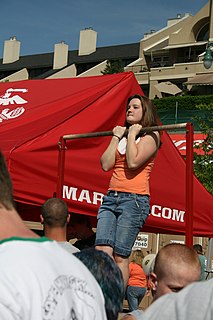 W
WThe chin-up is a strength training exercise. People frequently do this exercise with the intention of strengthening muscles such as the latissimus dorsi and biceps, which extend the shoulder and flex the elbow, respectively. In this maneuver, the palms are faced towards the body.
 W
WThe crunch is one of the most popular abdominal exercises. When performed properly, it engages all the abdominal muscles but primarily it works the rectus abdominis muscle and the obliques. It allows both building six-pack abs, and tightening the belly. Crunches use the exerciser's own body weight to tone muscle, and are recommended as a low-cost exercise that can be performed at home.
 W
WA dip is an upper-body strength exercise. Narrow, shoulder-width dips only train the triceps, with major synergists being the anterior deltoid, the pectoralis muscles, and the rhomboid muscles of the back. Wide arm training places additional emphasis on the pectoral muscles, similar in respect to the way a wide grip bench press would focus more on the pectorals and less on the triceps.
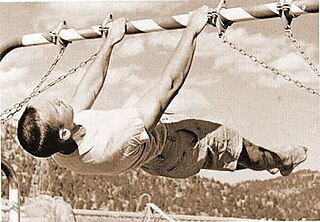 W
WThe front lever is a gymnastic and calisthenic move - a static hold normally performed on the still rings or the pull-up bar. A front lever is performed by lowering from an inverted hang until the body is completely horizontal and straight with the front of the body facing upwards. An accomplished gymnast may also pull directly into the horizontal position from a dead hang. Front levers require a high degree of back and core strength.
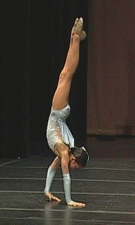 W
WHand walking is an unusual form of human locomotion in which a person travels in a vertically inverted orientation with all body weight resting on the hands. It can be executed with legs fully extended or with variations such as stag, straddle or front splits. Hand walking is performed in various athletic activities, including acro dance and circus acrobatics.
 W
WThe handstand push-up (press-up) - also called the vertical push-up (press-up) or the inverted push-up (press-up) also called "commandos"- is a type of push-up exercise where the body is positioned in a handstand. For a true handstand, the exercise is performed free-standing, held in the air. To prepare the strength until one has built adequate balance, the feet are often placed against a wall, held by a partner, or secured in some other way from falling. Handstand pushups require significant strength, as well as balance and control if performed free-standing.
 W
WThe human flag or bar hold is a feat of strength where the body is parallel to the ground supported by a vertical bar. A straight line is formed using the arms and body. The trick requires the performer to have extensive upper body strength.
 W
WHyperextension means a movement where extension is performed at any joint beyond its normal range of motion.
 W
WA jackknife is an abdominal exercise. This exercise is also known as a "V-Up". Jackknife exercises are designed to strengthen the upper and lower abdominal muscles, particularly the transversus abdominis muscle. There are a number of variations of jackknife exercises that allow people of different ages and ability to work their abdominal muscles. This exercise can be modified by using an exercise ball. The jackknife can be done by lying flat on your back with your arms extended overhead and your feet raised slightly above the floor. The jackknife is completed by slowly bringing your straight arms toward your hips, and lifting your upper torso off the floor.
 W
WThe L-sit is an acrobatic body position in which all body weight rests on the hands, with the torso held in a slightly forward-leaning orientation, with legs held horizontally so that each leg forms a nominal right-angle with the torso. The right-angle causes the body to have a notable "L" shape, hence the name "L-sit". It requires significant abdominal strength.
 W
WThe leg raise is a strength training exercise which targets the iliopsoas. Because the abdominal muscles are used isometrically to stabilize the body during the motion, leg raises are also often used to strengthen the rectus abdominis muscle and the internal and external oblique muscles.
 W
WA lunge can refer to any position of the human body where one leg is positioned forward with knee bent and foot flat on the ground while the other leg is positioned behind. It is used by athletes in cross-training for sports, by weight-trainers as a fitness exercise, and by practitioners of yoga as part of an asana regimen.
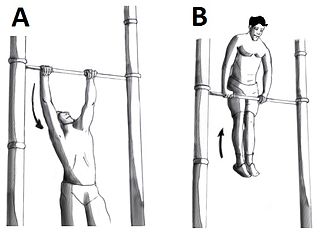 W
WThe muscle-up is an advanced strength training exercise, within the domain of calisthenics. It is a combination routine of a radial pull-up followed by a dip. Variations exist for the rings as well as the bar.
 W
WPelvic lift is an exercise to strengthen the lower back, glute muscles, lower abdominal muscles, and maintain hip muscle balance. It does not require weights, although they can be placed on the stomach.
 W
WPelvic tilt is the orientation of the pelvis in respect to the thighbones and the rest of the body. The pelvis can tilt towards the front, back, or either side of the body.
 W
WPilates is a type of mind-body exercise developed in the early 20th century by Joseph Pilates, after whom it was named. Pilates called his method "Contrology". It is practiced worldwide, especially in Western countries such as Australia, Canada, the United States and the United Kingdom. As of 2005, there were 11 million people practicing the discipline regularly and 14,000 instructors in the United States.
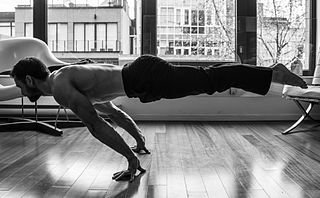 W
WA planche is a skill in gymnastics and calisthenics in which the body is held parallel to the ground, while being supported above the floor by straight arms. It is a move that requires significant strength and balance.
 W
WThe plank is an isometric core strength exercise that involves maintaining a position similar to a push-up for the maximum possible time.
 W
WA pull-up is an upper-body strength exercise. The pull-up is a closed-chain movement where the body is suspended by the hands and pulls up. As this happens, the elbows flex and the shoulders adduct and extend to bring the elbows to the torso.
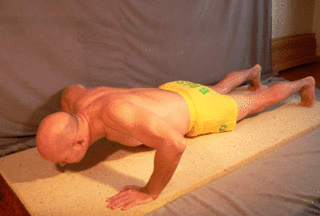 W
WA push-up is a common calisthenics exercise beginning from the prone position. By raising and lowering the body using the arms, push-ups exercise the pectoral muscles, triceps, and anterior deltoids, with ancillary benefits to the rest of the deltoids, serratus anterior, coracobrachialis and the midsection as a whole. Push-ups are a basic exercise used in civilian athletic training or physical education and commonly in military physical training. They are also a common form of punishment used in the military, school sport, and some martial arts disciplines.
 W
WThe Roman chair is a piece of exercise equipment. The equipment is mainly used for the lower back, but can also target the gluteal muscles, hamstring and abdominals. The definition of the equipment, and what 'Roman chair exercise' specifically means, is not clear.
 W
WThe sit-up is an abdominal endurance training exercise to strengthen, tighten and tone the abdominal muscles. It is similar to a crunch, but sit-ups have a fuller range of motion and condition additional muscles.
 W
WA squat is a strength exercise in which the trainee lowers their hips from a standing position and then stands back up. During the descent of a squat, the hip and knee joints flex while the ankle joint dorsiflexes; conversely the hip and knee joints extend and the ankle joint plantarflexes when standing up.
 W
WThe squat thrust is a calisthenic exercise. It typically is performed as follows:Bend your knees and drop into a squat position, then fall forward, placing your hands on the ground, into the push-up position. Throwing your feet back, fall forward into a push-up position. Again pull the feet forward to a squat position with hands on the floor.
 W
WStair climbing is the climbing of a flight of stairs. It is often described as a "low-impact" exercise, often for people who have recently started trying to get in shape. A common exhortation in health pop culture is "Take the stairs, not the elevator".
 W
WYoga is a group of physical, mental, and spiritual practices or disciplines that originated in ancient India, aimed at controlling ('yoking') and stilling the mind, and recognizing the detached 'witness-consciousness' as untouched by the activities of the mind (Citta) and mundane suffering (Duḥkha). There are a broad variety of the schools of yoga, practices, and goals in Hinduism, Buddhism, and Jainism, and traditional forms and modern methods of yoga are practiced worldwide.